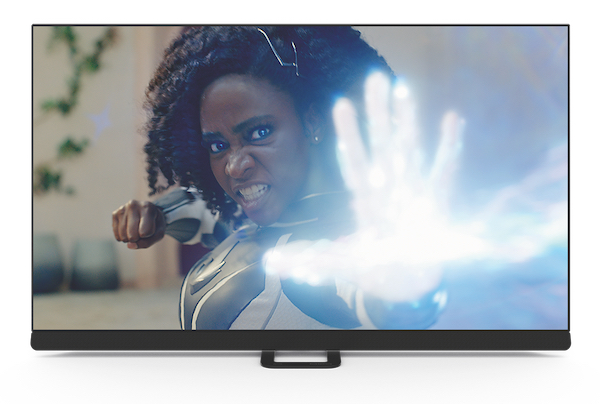Philips 55OLED+908 4K TV review

 Philips' MLA OLED TV is a bright performer, enthuses Steve May, but it's not the smartest in its class
Philips' MLA OLED TV is a bright performer, enthuses Steve May, but it's not the smartest in its classIntroducing the OLED+908, the first MLA (Micro Lens Array) OLED flatscreen from Philips, and available in the 55in iteration tested here for around £1,800. That's not an inconsiderable sum for a telly of its size, but as is the current direction of travel in the 4K TV market, it arrives promising higher peak brightness than we've seen from the brand before, plus plenty of other premium treats.
This flagship set, also offered at 65in and 77in, ushers in some significant differences at component level, a sound system designed by Bowers & Wilkins, and a 'Next Generation' implementation of Philips' Ambilight smart lighting array. There's clearly a lot to unpack here…
A touch of style
Let's start at the back, where the three-sided Ambilight system employed by the OLED+908 offers copious room illumination options. I've long been a fan of this now 20-year-old technology; as a lifestyle benefit, it can really alter the mood of any living space. I find it to be particularly compelling when gaming and watching sports, or simply used as a static colour backdrop. The only niggle about
it here is that, if you plan to wall mount, the lack of a full four-sided array does somewhat undermine the light show.
Design is a definite strong point of the OLED+908. The set sports an infinitesimal metal bezel, and the speaker grille is finished in matching dark Kvadrat cloth. The panel itself sits on an easy to accommodate central pedestal stand, and enjoys a healthy amount of swivel.
The remote control is also rather slick. It still feels premium, but is more compact in the hand than previous Philips zappers, with fewer obvious buttons, although shortcuts for Netflix, YouTube and Prime Video remain. And you no longer have to wrestle with the rear of the remote to replace batteries; this wand is USB-C chargeable. It's also backlit, which is a nice touch.

Connectivity, including a subwoofer pre-out and trio of USBs, will be more than adequate for most users. Some, on the other hand, will be frustrated that of the TV's four HDMI inputs, only two support HFR (4K/120) sources, and one of those doubles as the ARC/eARC connection.
The sound system here is rather less elaborate than we've seen on previous Philips/Bowers & Wilkins collaborations, but it's still a cut above. Hidden behind the cloth grille is a forward-facing array, with left, centre and right channels handled by 30mm midrange and 19mm titanium dome tweeter pairings. Low-frequency support comes via a rear-mounted 75mm subwoofer, flanked by passive radiators.
The TV supports DTS:X audio as well as Dolby Atmos. It's also DTS Play-Fi compatible, and can be used within an existing whole-home DTS Play-Fi ecosystem.
Made to measure
Powering the glass is Philips' single-chip P5 AI processor. The enhanced capabilities of this new silicon have opened the door to more ambitious processing, including second-generation Ambient Intelligence, with light level, dark detail and colour temperature optimisation.
In other words, the screen will adjust brightness depending on your living room conditions, while preserving darker details when viewing in bright light. The enabler is a new RGB sensor able to measure
the colour temperature
of light in your room.
There's no doubt there's a lot of science at play here, but does it result in better image quality? I'm not entirely convinced. I found myself back in this particular menu more times than I would like, concluding that in some ways this iteration of Ambient Intelligence was actually adding unpredictable artifice to images. Obviously it's doing what it was intended to do, but its various alterations were upsetting my PQ equilibrium. With all due respect to Philips engineering wizards, I felt happier watching with it turned off.

Other usability refinements are more successful, like being able to bank your preferred movie picture style, and having it trigger without needing any manual intervention. Automatic selection can come using either Content Signalling, or via the P5 picture engine AI.
HDR hero
So just how bright is the OLED+908's MLA OLED panel?
In its HDR Crystal Clear mode, using a standard 10 per cent measurement window, I recorded peak brightness just under 1,000 nits; dropping to a five per cent window, this jumps to 1,400 nits. The HDR Home Cinema preset, with the same five per cent patch, yields virtually an identical result. There's more than enough headroom here to avoid tone mapping with HDR-encoded broadcast and streaming content, and the set's average picture level is easily bright enough to watch in daylight without sacrificing vibrancy. This inherent luminosity isn't immediately apparent, though. You'll need to change the out-of-the-box picture default from its energy-saving Eco mode, as this dims the image considerably.
Viewing choices comprise Personal, Crystal Clear, Home Cinema, Eco and Filmmaker Mode. The most overtly punchy is Crystal Clear, although it doesn't oversaturate in a way that traditional 'Vivid' modes sometimes do. Greens can be a little bit garish, but it still has a lot of appeal. Pacific Rim Uprising (4K Blu-ray) provided plenty of opportunity for the set to shine, with its glorious neon colour palette and highly dynamic action sequences.
The Home Cinema mode, which makes concessions to colour temperature, is also pretty successful when it comes to picture balance. Reacher (Season 2, Prime Video) might not be a movie but it certainly looks very cinematic on the OLED+908. Selecting Filmmaker Mode, however, feels like dropping into first gear.
The audio from the 55OLED+908 is properly punchy, as it should be with a total power output rated at 80W. The set is especially good when it comes to dialogue clarity and soundstaging. The banter between Reacher and his team is never lost, and there's a good sense of movement during action scenes like the biker punch-up in Episode 4.
Don't expect really deep bass, though. Running through the Jaeger on Jaeger battle from Pacific Rim Uprising (Chapter 10), the fisticuffs sounded not quite as bold and brutal as they should.
Various sound styles (including a Music setting optimised by B&W) can be chosen within the OLED+908's menus, and the TV's usability in general is well-considered. Philips' menu system is more intuitive than before, which means quicker access to key functionality. It's a definite step in the right direction.
But there's a catch in that the company has migrated its smart platform from Android to Google TV. A more content-specific iteration of the familiar Android OS, Google TV offers improved content curation but comes with an unfortunate side effect. At the time of review it couldn't coexist with Freeview Play, and that meant BBC iPlayer and other UK catch-up services were AWOL – this is likely to be more of a deal-breaker than a couple of limited-bandwidth HDMI inputs.
Aiming high
The OLED+908 is therefore not quite the slam-dunk premium set. Image quality is superb, combining vibrant colour fidelity with excellent HDR handling, and the audio system sounds precise, detailed and involving. Yet the
lack of Freeview Play and UK catch-up services means you will need to look for another device to satisfy mainstream streaming needs, and I also think it's worth treating some of the OLED+908's new AI confections with caution.
You can't help but admire Philips' ambition, though.
HCC Verdict: 4.5/5
Philips 55OLED+908
Price: £1,799
www.philips.co.uk
We say: Philips' MLA debut is a wow when it comes to HDR dynamics and Ambilight, but you'll need to look elsewhere for a comprehensive smart platform.
Specifications
4K: Yes. 3,840 x 2,160 HDR: Yes. HDR10; HDR10+; Dolby Vision; HLG CONNECTIONS:: 4 x HDMI; 3 x USB; Ethernet; subwoofer pre-out; optical digital audio output; headphone out 4K/120 PLAYBACK: Yes SOUND (CLAIMED): 80W-rated 3.1-channel BRIGHTNESS (CLAIMED): Peak 2,100 nits CONTRAST (CLAIMED): Not given DIMENSIONS (OFF STAND): 1,444(w) x 869(h) x 71(d)mm WEIGHT (OFF STAND): 25kg
FEATURES: Built-in Wi-Fi; P5 AI picture engine; IMAX Enhanced; three-sided Ambilight; Bowers & Wilkins audio; Dolby Atmos decoder; Google TV OS; DTS Play-Fi; DTS:X; MLA OLED panel; Ambient Intelligence; VRR including FreeSync Premium and Nvidia G-Sync; Dolby Vision Game mode
 |
Home Cinema Choice #351 is on sale now, featuring: Samsung S95D flagship OLED TV; Ascendo loudspeakers; Pioneer VSA-LX805 AV receiver; UST projector roundup; 2024’s summer movies; Conan 4K; and more
|


















































